BSBWHS501: Third Party Observation and Assessment for a Safe Workplace
VerifiedAdded on 2022/08/24
|44
|6598
|21
Homework Assignment
AI Summary
This document is a third-party observation assessment for the BSBWHS501 unit, which focuses on ensuring a safe workplace. The assessment involves a detailed evaluation of a learner's ability to establish, implement, and maintain a work health and safety (WHS) management system. The third party, who has observed the learner's performance, answers a series of questions about the learner's actions, including how they locate, adapt, and communicate WHS policies; identify duty holders and their responsibilities; identify and approve resources; work with employees on participation arrangements; resolve WHS issues; provide information about outcomes; develop hazard identification, assessment, and control procedures; select and implement risk controls; identify inadequacies in risk controls; request expert WHS advice; and provide WHS induction and training programs. The assessment covers various aspects of workplace safety, including hazard identification, risk management, and compliance with WHS legislation, with the third party providing factual observations based on direct, indirect, or supplementary evidence. The assessment also includes an evaluation of the WHSMS and improvements to achieve organizational objectives and ensure compliance.
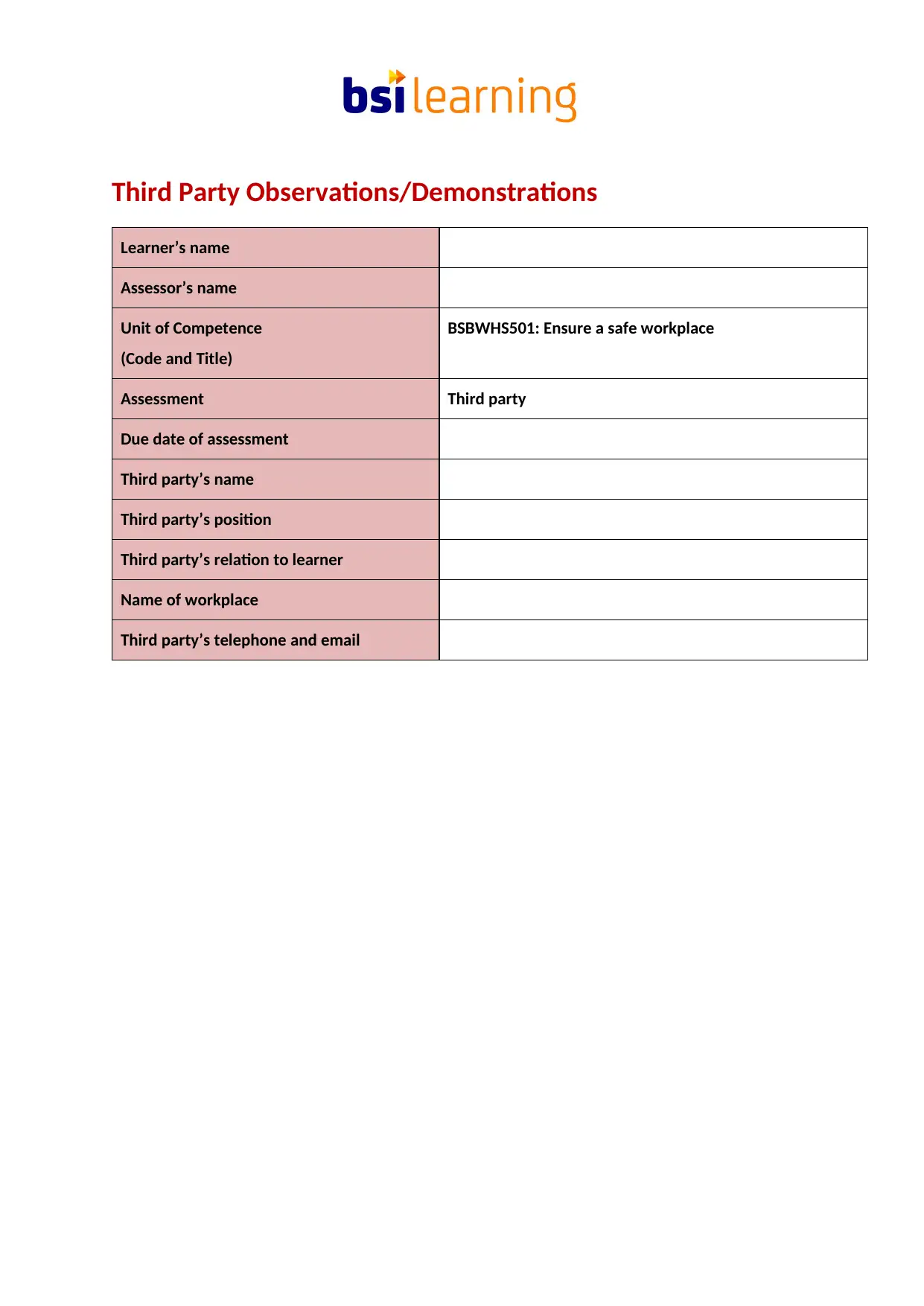
Third Party Observations/Demonstrations
Learner’s name
Assessor’s name
Unit of Competence
(Code and Title)
BSBWHS501: Ensure a safe workplace
Assessment Third party
Due date of assessment
Third party’s name
Third party’s position
Third party’s relation to learner
Name of workplace
Third party’s telephone and email
Learner’s name
Assessor’s name
Unit of Competence
(Code and Title)
BSBWHS501: Ensure a safe workplace
Assessment Third party
Due date of assessment
Third party’s name
Third party’s position
Third party’s relation to learner
Name of workplace
Third party’s telephone and email
Paraphrase This Document
Need a fresh take? Get an instant paraphrase of this document with our AI Paraphraser
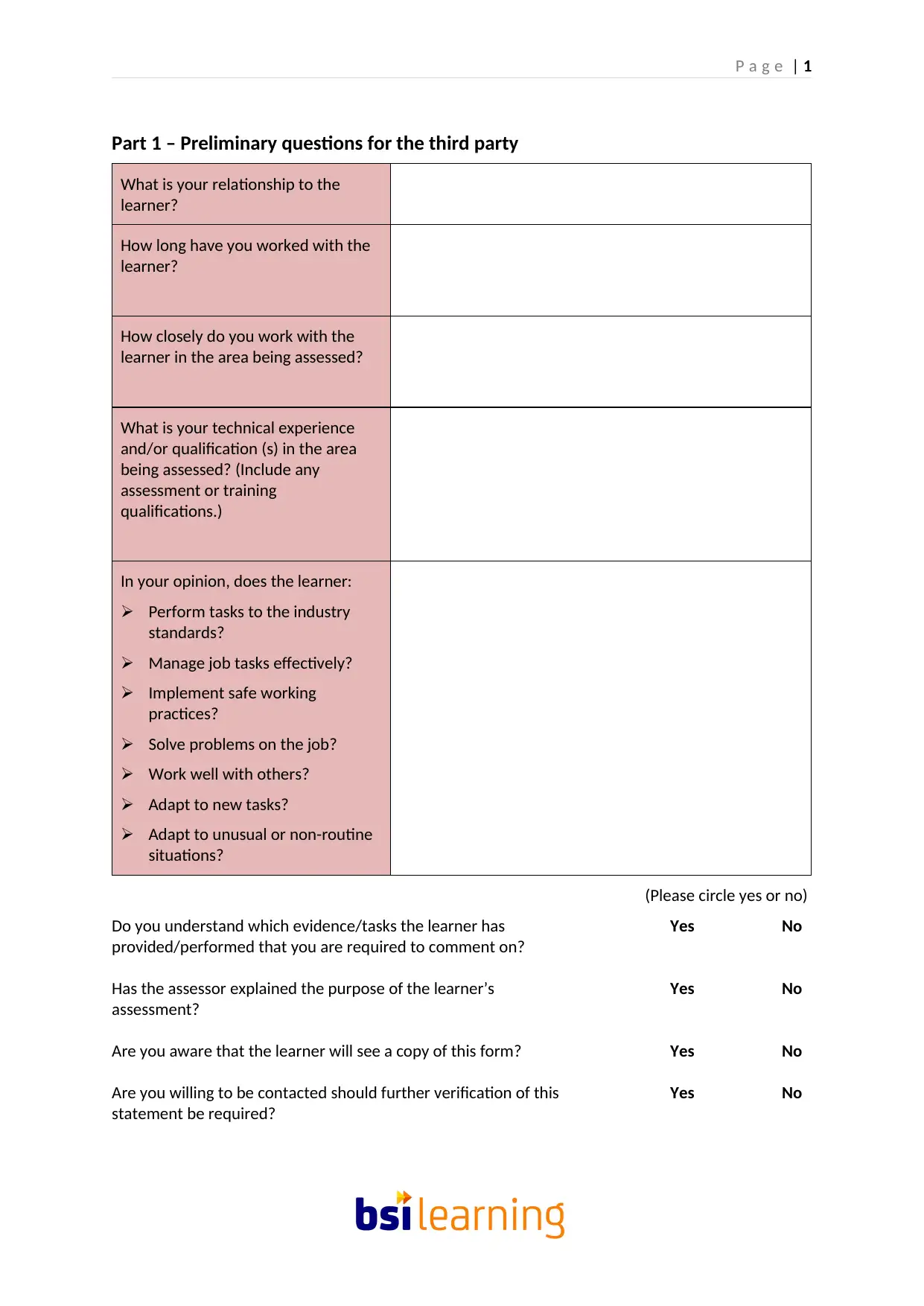
P a g e | 1
Part 1 – Preliminary questions for the third party
What is your relationship to the
learner?
How long have you worked with the
learner?
How closely do you work with the
learner in the area being assessed?
What is your technical experience
and/or qualification (s) in the area
being assessed? (Include any
assessment or training
qualifications.)
In your opinion, does the learner:
Perform tasks to the industry
standards?
Manage job tasks effectively?
Implement safe working
practices?
Solve problems on the job?
Work well with others?
Adapt to new tasks?
Adapt to unusual or non-routine
situations?
(Please circle yes or no)
Do you understand which evidence/tasks the learner has Yes No
provided/performed that you are required to comment on?
Has the assessor explained the purpose of the learner’s Yes No
assessment?
Are you aware that the learner will see a copy of this form? Yes No
Are you willing to be contacted should further verification of this Yes No
statement be required?
Part 1 – Preliminary questions for the third party
What is your relationship to the
learner?
How long have you worked with the
learner?
How closely do you work with the
learner in the area being assessed?
What is your technical experience
and/or qualification (s) in the area
being assessed? (Include any
assessment or training
qualifications.)
In your opinion, does the learner:
Perform tasks to the industry
standards?
Manage job tasks effectively?
Implement safe working
practices?
Solve problems on the job?
Work well with others?
Adapt to new tasks?
Adapt to unusual or non-routine
situations?
(Please circle yes or no)
Do you understand which evidence/tasks the learner has Yes No
provided/performed that you are required to comment on?
Has the assessor explained the purpose of the learner’s Yes No
assessment?
Are you aware that the learner will see a copy of this form? Yes No
Are you willing to be contacted should further verification of this Yes No
statement be required?
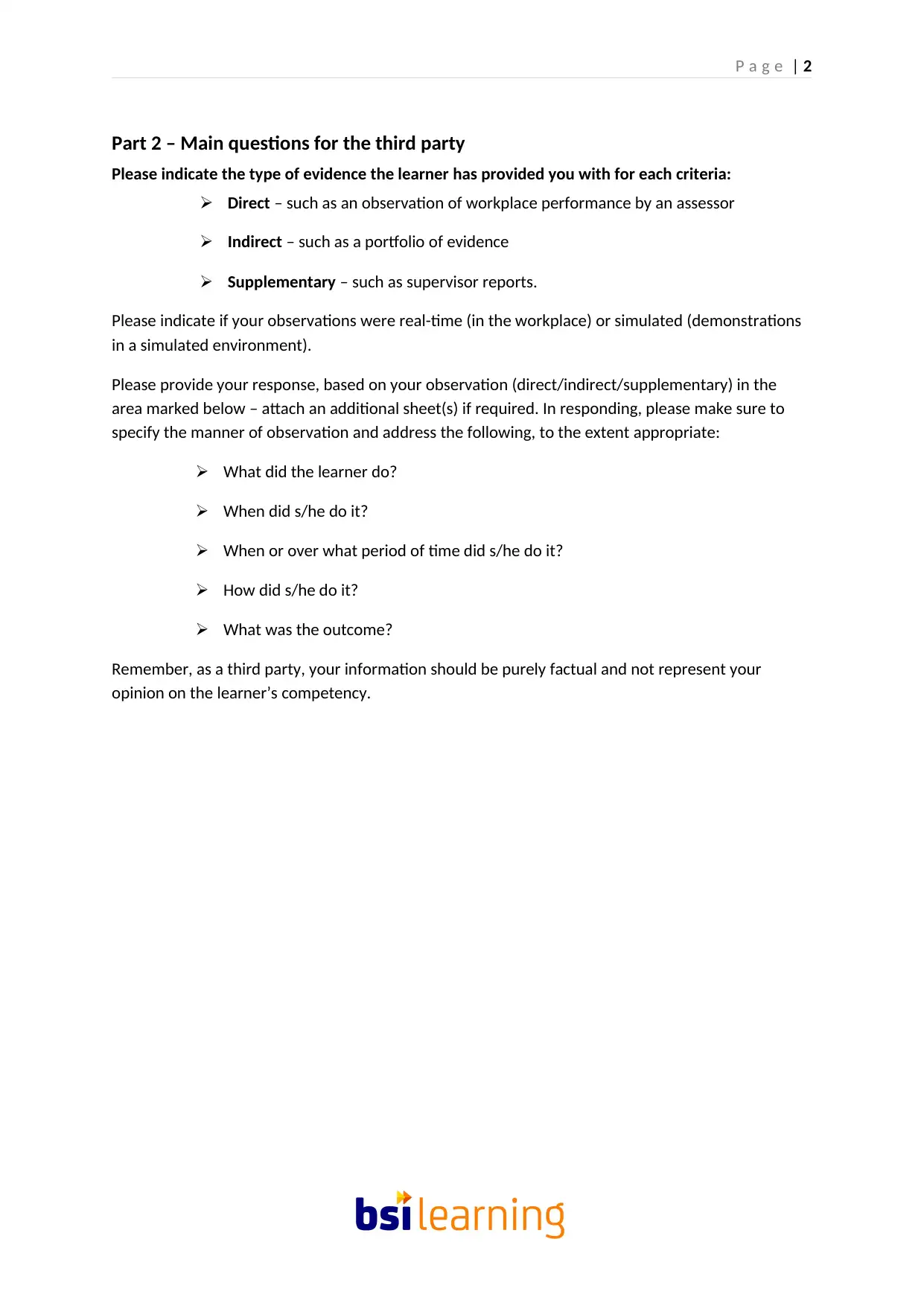
P a g e | 2
Part 2 – Main questions for the third party
Please indicate the type of evidence the learner has provided you with for each criteria:
Direct – such as an observation of workplace performance by an assessor
Indirect – such as a portfolio of evidence
Supplementary – such as supervisor reports.
Please indicate if your observations were real-time (in the workplace) or simulated (demonstrations
in a simulated environment).
Please provide your response, based on your observation (direct/indirect/supplementary) in the
area marked below – attach an additional sheet(s) if required. In responding, please make sure to
specify the manner of observation and address the following, to the extent appropriate:
What did the learner do?
When did s/he do it?
When or over what period of time did s/he do it?
How did s/he do it?
What was the outcome?
Remember, as a third party, your information should be purely factual and not represent your
opinion on the learner’s competency.
Part 2 – Main questions for the third party
Please indicate the type of evidence the learner has provided you with for each criteria:
Direct – such as an observation of workplace performance by an assessor
Indirect – such as a portfolio of evidence
Supplementary – such as supervisor reports.
Please indicate if your observations were real-time (in the workplace) or simulated (demonstrations
in a simulated environment).
Please provide your response, based on your observation (direct/indirect/supplementary) in the
area marked below – attach an additional sheet(s) if required. In responding, please make sure to
specify the manner of observation and address the following, to the extent appropriate:
What did the learner do?
When did s/he do it?
When or over what period of time did s/he do it?
How did s/he do it?
What was the outcome?
Remember, as a third party, your information should be purely factual and not represent your
opinion on the learner’s competency.
⊘ This is a preview!⊘
Do you want full access?
Subscribe today to unlock all pages.

Trusted by 1+ million students worldwide
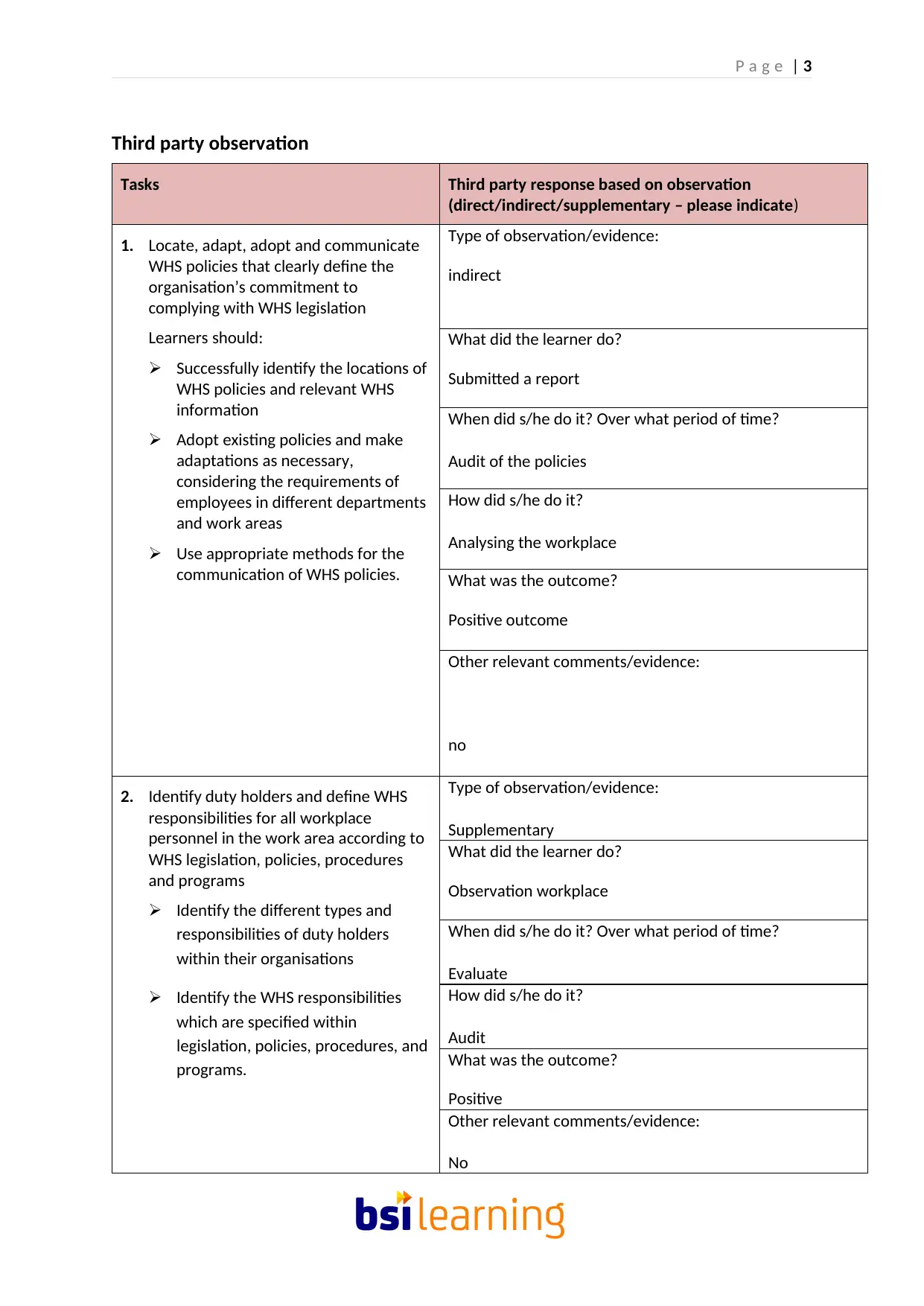
P a g e | 3
Third party observation
Tasks Third party response based on observation
(direct/indirect/supplementary – please indicate)
1. Locate, adapt, adopt and communicate
WHS policies that clearly define the
organisation’s commitment to
complying with WHS legislation
Learners should:
Successfully identify the locations of
WHS policies and relevant WHS
information
Adopt existing policies and make
adaptations as necessary,
considering the requirements of
employees in different departments
and work areas
Use appropriate methods for the
communication of WHS policies.
Type of observation/evidence:
indirect
What did the learner do?
Submitted a report
When did s/he do it? Over what period of time?
Audit of the policies
How did s/he do it?
Analysing the workplace
What was the outcome?
Positive outcome
Other relevant comments/evidence:
no
2. Identify duty holders and define WHS
responsibilities for all workplace
personnel in the work area according to
WHS legislation, policies, procedures
and programs
Identify the different types and
responsibilities of duty holders
within their organisations
Identify the WHS responsibilities
which are specified within
legislation, policies, procedures, and
programs.
Type of observation/evidence:
Supplementary
What did the learner do?
Observation workplace
When did s/he do it? Over what period of time?
Evaluate
How did s/he do it?
Audit
What was the outcome?
Positive
Other relevant comments/evidence:
No
Third party observation
Tasks Third party response based on observation
(direct/indirect/supplementary – please indicate)
1. Locate, adapt, adopt and communicate
WHS policies that clearly define the
organisation’s commitment to
complying with WHS legislation
Learners should:
Successfully identify the locations of
WHS policies and relevant WHS
information
Adopt existing policies and make
adaptations as necessary,
considering the requirements of
employees in different departments
and work areas
Use appropriate methods for the
communication of WHS policies.
Type of observation/evidence:
indirect
What did the learner do?
Submitted a report
When did s/he do it? Over what period of time?
Audit of the policies
How did s/he do it?
Analysing the workplace
What was the outcome?
Positive outcome
Other relevant comments/evidence:
no
2. Identify duty holders and define WHS
responsibilities for all workplace
personnel in the work area according to
WHS legislation, policies, procedures
and programs
Identify the different types and
responsibilities of duty holders
within their organisations
Identify the WHS responsibilities
which are specified within
legislation, policies, procedures, and
programs.
Type of observation/evidence:
Supplementary
What did the learner do?
Observation workplace
When did s/he do it? Over what period of time?
Evaluate
How did s/he do it?
Audit
What was the outcome?
Positive
Other relevant comments/evidence:
No
Paraphrase This Document
Need a fresh take? Get an instant paraphrase of this document with our AI Paraphraser
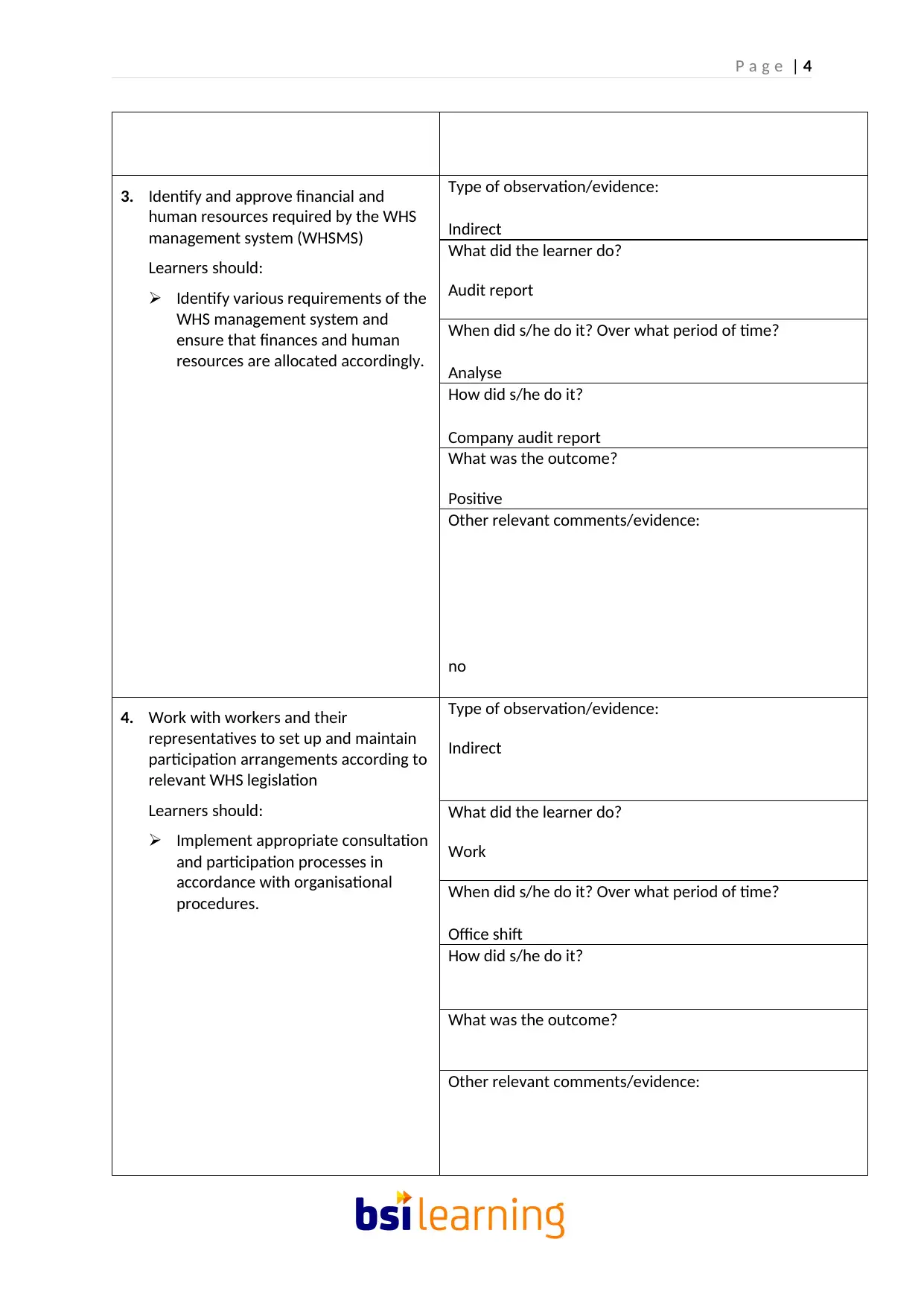
P a g e | 4
3. Identify and approve financial and
human resources required by the WHS
management system (WHSMS)
Learners should:
Identify various requirements of the
WHS management system and
ensure that finances and human
resources are allocated accordingly.
Type of observation/evidence:
Indirect
What did the learner do?
Audit report
When did s/he do it? Over what period of time?
Analyse
How did s/he do it?
Company audit report
What was the outcome?
Positive
Other relevant comments/evidence:
no
4. Work with workers and their
representatives to set up and maintain
participation arrangements according to
relevant WHS legislation
Learners should:
Implement appropriate consultation
and participation processes in
accordance with organisational
procedures.
Type of observation/evidence:
Indirect
What did the learner do?
Work
When did s/he do it? Over what period of time?
Office shift
How did s/he do it?
What was the outcome?
Other relevant comments/evidence:
3. Identify and approve financial and
human resources required by the WHS
management system (WHSMS)
Learners should:
Identify various requirements of the
WHS management system and
ensure that finances and human
resources are allocated accordingly.
Type of observation/evidence:
Indirect
What did the learner do?
Audit report
When did s/he do it? Over what period of time?
Analyse
How did s/he do it?
Company audit report
What was the outcome?
Positive
Other relevant comments/evidence:
no
4. Work with workers and their
representatives to set up and maintain
participation arrangements according to
relevant WHS legislation
Learners should:
Implement appropriate consultation
and participation processes in
accordance with organisational
procedures.
Type of observation/evidence:
Indirect
What did the learner do?
Work
When did s/he do it? Over what period of time?
Office shift
How did s/he do it?
What was the outcome?
Other relevant comments/evidence:
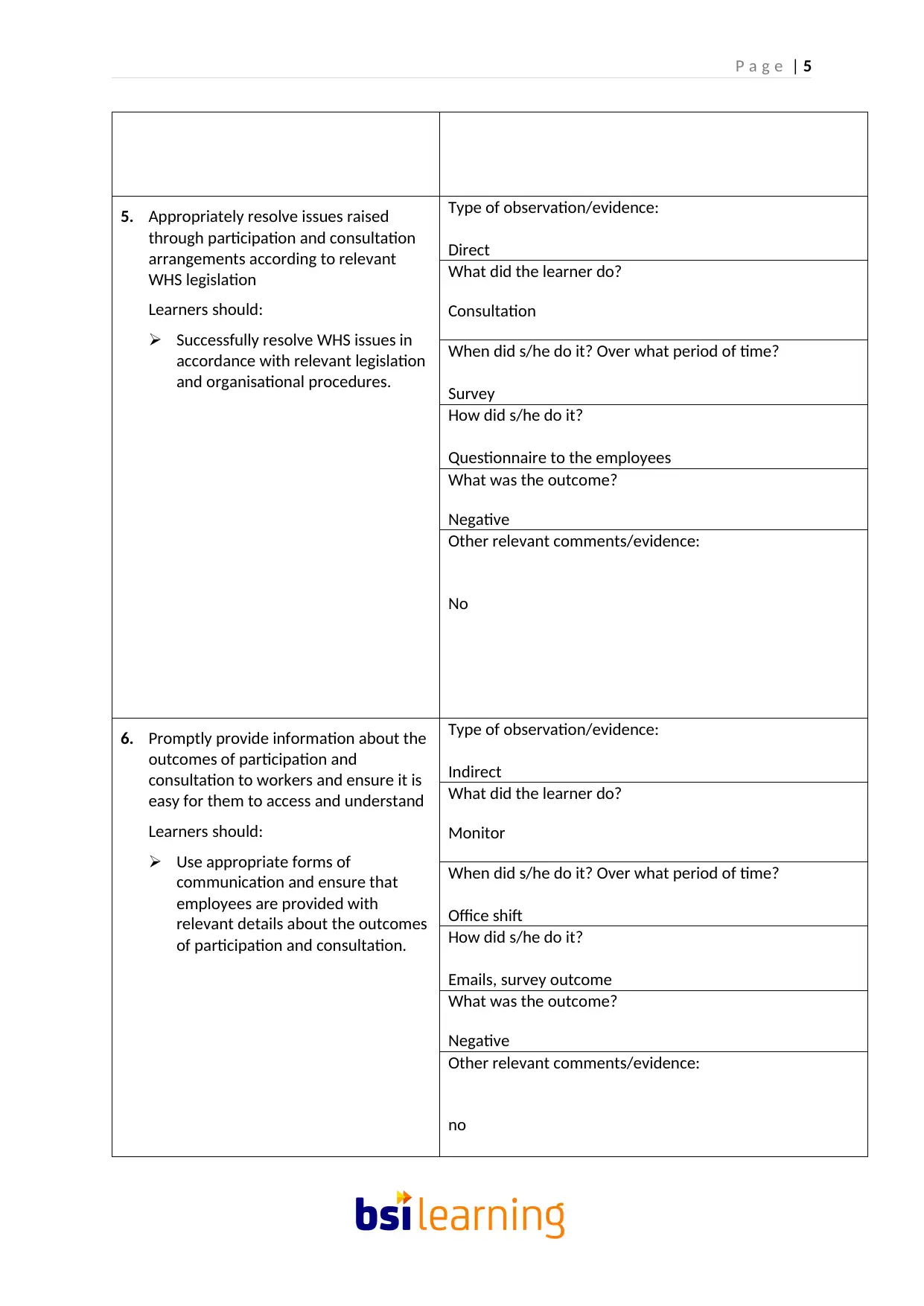
P a g e | 5
5. Appropriately resolve issues raised
through participation and consultation
arrangements according to relevant
WHS legislation
Learners should:
Successfully resolve WHS issues in
accordance with relevant legislation
and organisational procedures.
Type of observation/evidence:
Direct
What did the learner do?
Consultation
When did s/he do it? Over what period of time?
Survey
How did s/he do it?
Questionnaire to the employees
What was the outcome?
Negative
Other relevant comments/evidence:
No
6. Promptly provide information about the
outcomes of participation and
consultation to workers and ensure it is
easy for them to access and understand
Learners should:
Use appropriate forms of
communication and ensure that
employees are provided with
relevant details about the outcomes
of participation and consultation.
Type of observation/evidence:
Indirect
What did the learner do?
Monitor
When did s/he do it? Over what period of time?
Office shift
How did s/he do it?
Emails, survey outcome
What was the outcome?
Negative
Other relevant comments/evidence:
no
5. Appropriately resolve issues raised
through participation and consultation
arrangements according to relevant
WHS legislation
Learners should:
Successfully resolve WHS issues in
accordance with relevant legislation
and organisational procedures.
Type of observation/evidence:
Direct
What did the learner do?
Consultation
When did s/he do it? Over what period of time?
Survey
How did s/he do it?
Questionnaire to the employees
What was the outcome?
Negative
Other relevant comments/evidence:
No
6. Promptly provide information about the
outcomes of participation and
consultation to workers and ensure it is
easy for them to access and understand
Learners should:
Use appropriate forms of
communication and ensure that
employees are provided with
relevant details about the outcomes
of participation and consultation.
Type of observation/evidence:
Indirect
What did the learner do?
Monitor
When did s/he do it? Over what period of time?
Office shift
How did s/he do it?
Emails, survey outcome
What was the outcome?
Negative
Other relevant comments/evidence:
no
⊘ This is a preview!⊘
Do you want full access?
Subscribe today to unlock all pages.

Trusted by 1+ million students worldwide
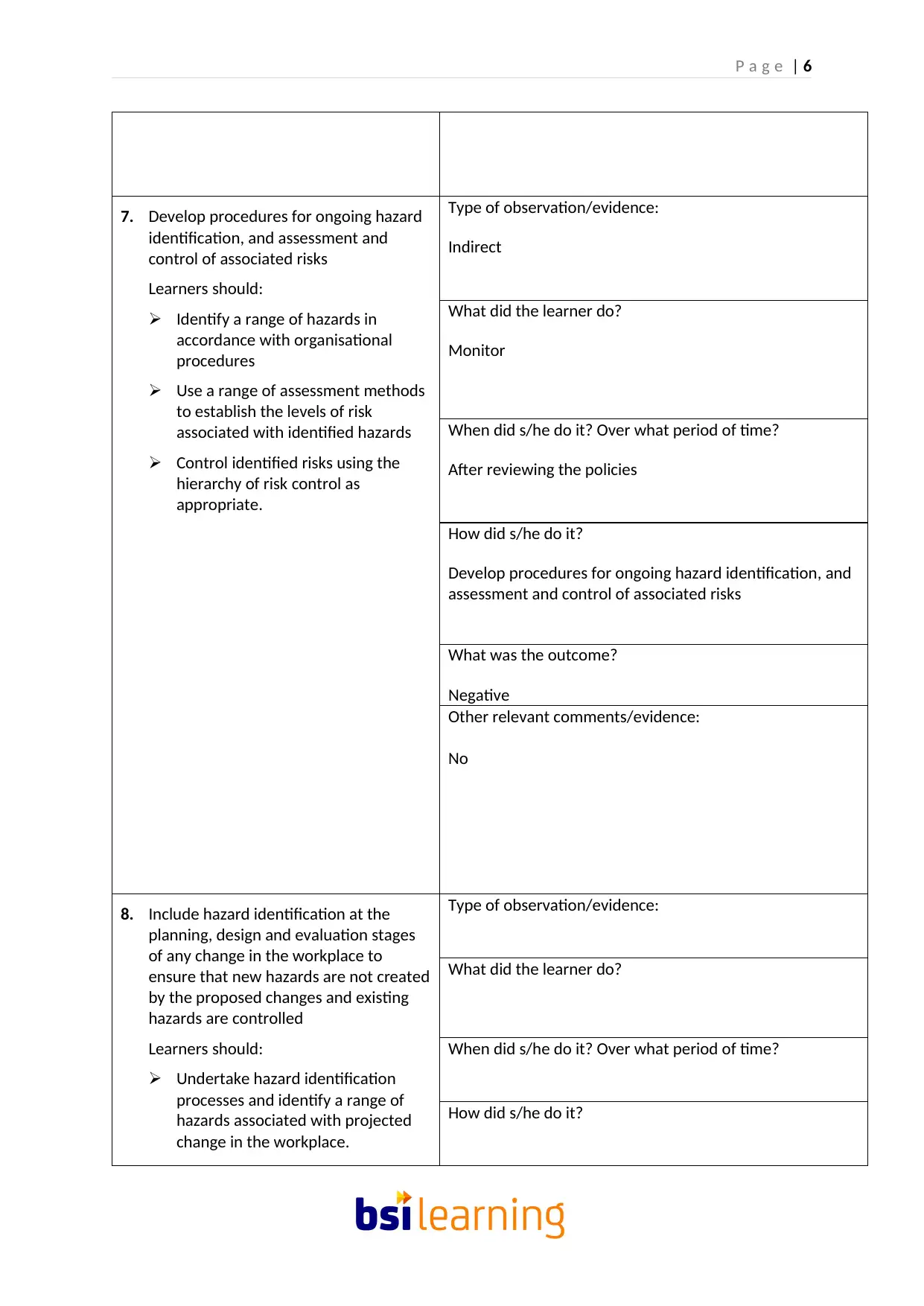
P a g e | 6
7. Develop procedures for ongoing hazard
identification, and assessment and
control of associated risks
Learners should:
Identify a range of hazards in
accordance with organisational
procedures
Use a range of assessment methods
to establish the levels of risk
associated with identified hazards
Control identified risks using the
hierarchy of risk control as
appropriate.
Type of observation/evidence:
Indirect
What did the learner do?
Monitor
When did s/he do it? Over what period of time?
After reviewing the policies
How did s/he do it?
Develop procedures for ongoing hazard identification, and
assessment and control of associated risks
What was the outcome?
Negative
Other relevant comments/evidence:
No
8. Include hazard identification at the
planning, design and evaluation stages
of any change in the workplace to
ensure that new hazards are not created
by the proposed changes and existing
hazards are controlled
Learners should:
Undertake hazard identification
processes and identify a range of
hazards associated with projected
change in the workplace.
Type of observation/evidence:
What did the learner do?
When did s/he do it? Over what period of time?
How did s/he do it?
7. Develop procedures for ongoing hazard
identification, and assessment and
control of associated risks
Learners should:
Identify a range of hazards in
accordance with organisational
procedures
Use a range of assessment methods
to establish the levels of risk
associated with identified hazards
Control identified risks using the
hierarchy of risk control as
appropriate.
Type of observation/evidence:
Indirect
What did the learner do?
Monitor
When did s/he do it? Over what period of time?
After reviewing the policies
How did s/he do it?
Develop procedures for ongoing hazard identification, and
assessment and control of associated risks
What was the outcome?
Negative
Other relevant comments/evidence:
No
8. Include hazard identification at the
planning, design and evaluation stages
of any change in the workplace to
ensure that new hazards are not created
by the proposed changes and existing
hazards are controlled
Learners should:
Undertake hazard identification
processes and identify a range of
hazards associated with projected
change in the workplace.
Type of observation/evidence:
What did the learner do?
When did s/he do it? Over what period of time?
How did s/he do it?
Paraphrase This Document
Need a fresh take? Get an instant paraphrase of this document with our AI Paraphraser
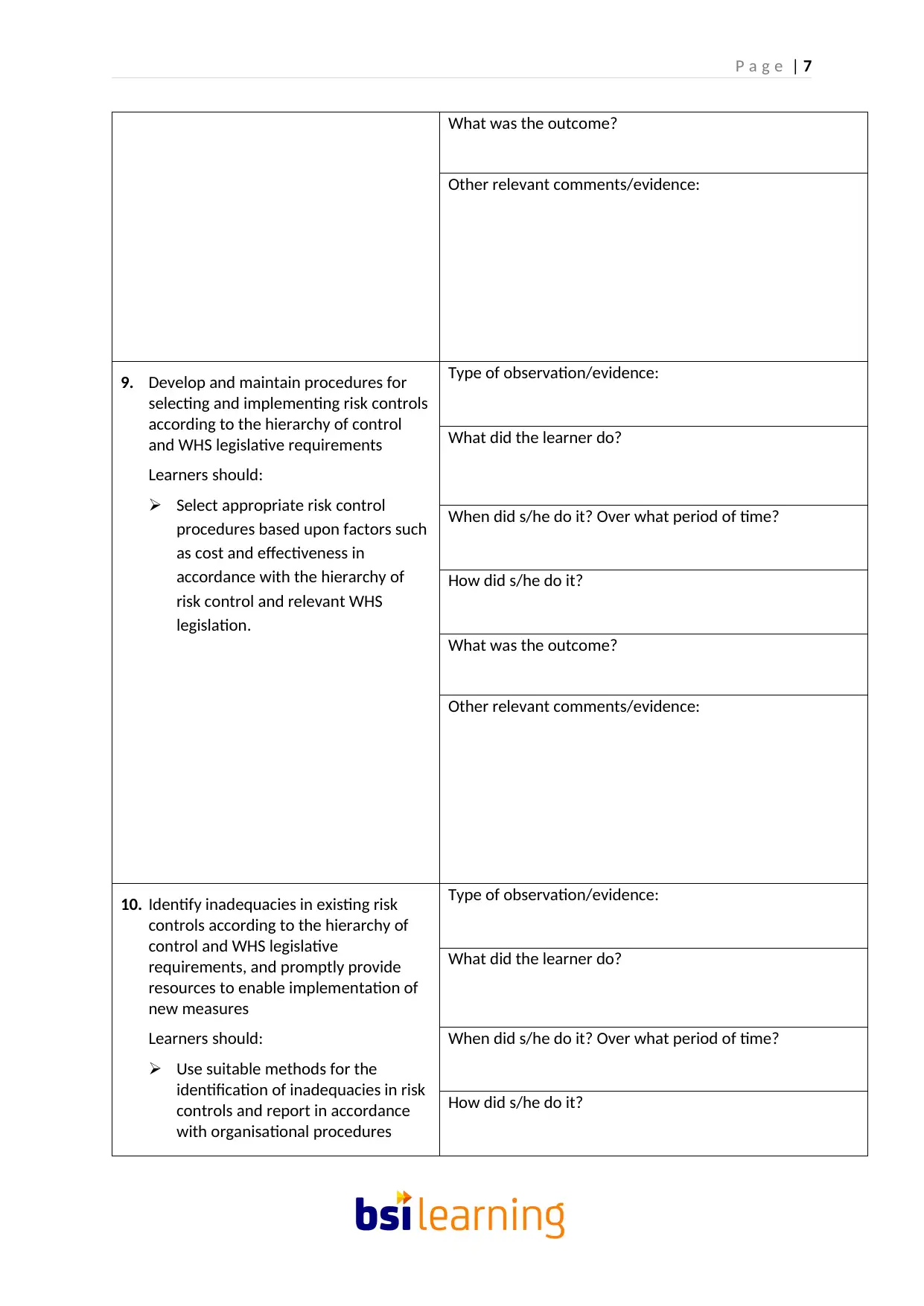
P a g e | 7
What was the outcome?
Other relevant comments/evidence:
9. Develop and maintain procedures for
selecting and implementing risk controls
according to the hierarchy of control
and WHS legislative requirements
Learners should:
Select appropriate risk control
procedures based upon factors such
as cost and effectiveness in
accordance with the hierarchy of
risk control and relevant WHS
legislation.
Type of observation/evidence:
What did the learner do?
When did s/he do it? Over what period of time?
How did s/he do it?
What was the outcome?
Other relevant comments/evidence:
10. Identify inadequacies in existing risk
controls according to the hierarchy of
control and WHS legislative
requirements, and promptly provide
resources to enable implementation of
new measures
Learners should:
Use suitable methods for the
identification of inadequacies in risk
controls and report in accordance
with organisational procedures
Type of observation/evidence:
What did the learner do?
When did s/he do it? Over what period of time?
How did s/he do it?
What was the outcome?
Other relevant comments/evidence:
9. Develop and maintain procedures for
selecting and implementing risk controls
according to the hierarchy of control
and WHS legislative requirements
Learners should:
Select appropriate risk control
procedures based upon factors such
as cost and effectiveness in
accordance with the hierarchy of
risk control and relevant WHS
legislation.
Type of observation/evidence:
What did the learner do?
When did s/he do it? Over what period of time?
How did s/he do it?
What was the outcome?
Other relevant comments/evidence:
10. Identify inadequacies in existing risk
controls according to the hierarchy of
control and WHS legislative
requirements, and promptly provide
resources to enable implementation of
new measures
Learners should:
Use suitable methods for the
identification of inadequacies in risk
controls and report in accordance
with organisational procedures
Type of observation/evidence:
What did the learner do?
When did s/he do it? Over what period of time?
How did s/he do it?
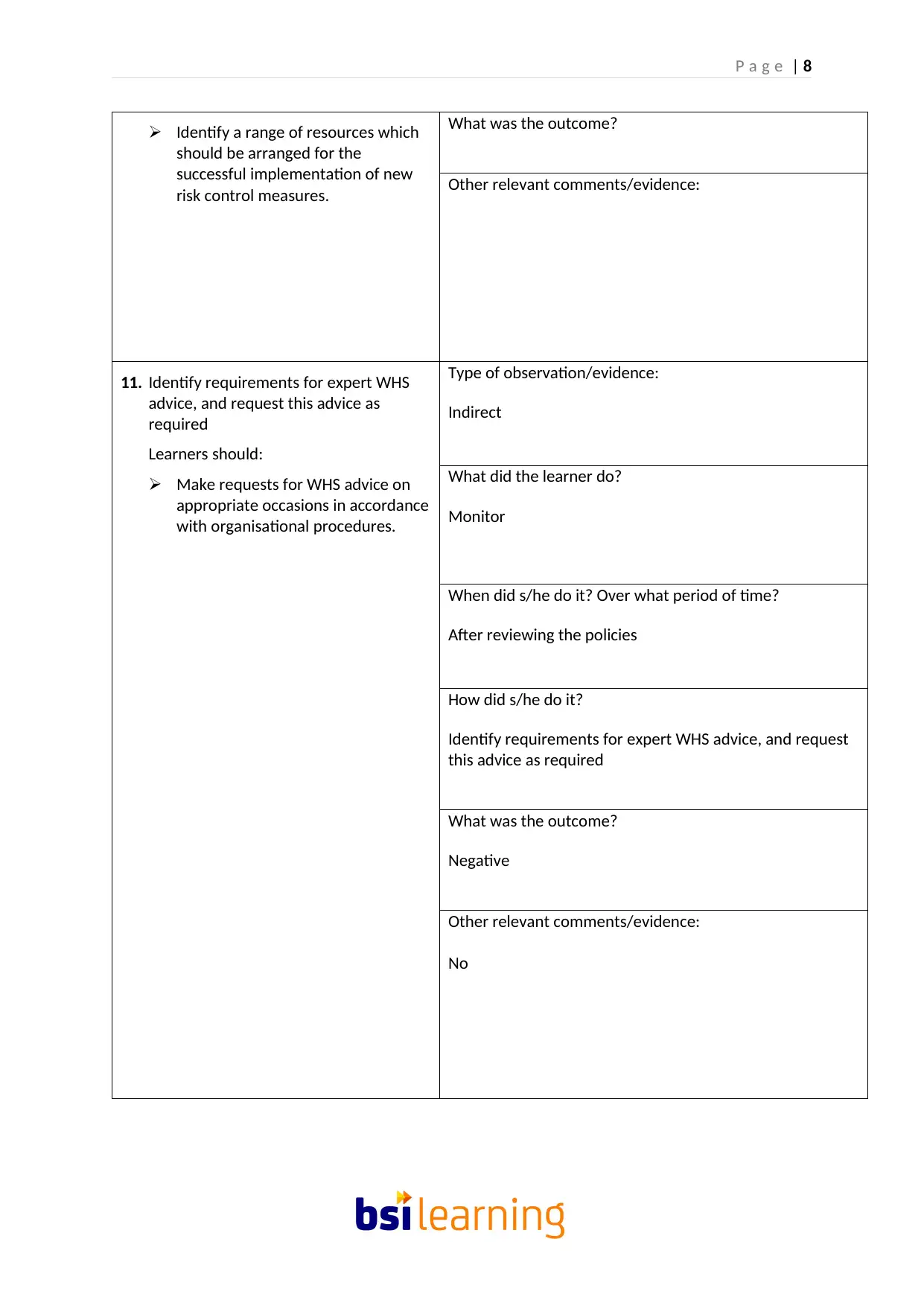
P a g e | 8
Identify a range of resources which
should be arranged for the
successful implementation of new
risk control measures.
What was the outcome?
Other relevant comments/evidence:
11. Identify requirements for expert WHS
advice, and request this advice as
required
Learners should:
Make requests for WHS advice on
appropriate occasions in accordance
with organisational procedures.
Type of observation/evidence:
Indirect
What did the learner do?
Monitor
When did s/he do it? Over what period of time?
After reviewing the policies
How did s/he do it?
Identify requirements for expert WHS advice, and request
this advice as required
What was the outcome?
Negative
Other relevant comments/evidence:
No
Identify a range of resources which
should be arranged for the
successful implementation of new
risk control measures.
What was the outcome?
Other relevant comments/evidence:
11. Identify requirements for expert WHS
advice, and request this advice as
required
Learners should:
Make requests for WHS advice on
appropriate occasions in accordance
with organisational procedures.
Type of observation/evidence:
Indirect
What did the learner do?
Monitor
When did s/he do it? Over what period of time?
After reviewing the policies
How did s/he do it?
Identify requirements for expert WHS advice, and request
this advice as required
What was the outcome?
Negative
Other relevant comments/evidence:
No
⊘ This is a preview!⊘
Do you want full access?
Subscribe today to unlock all pages.

Trusted by 1+ million students worldwide
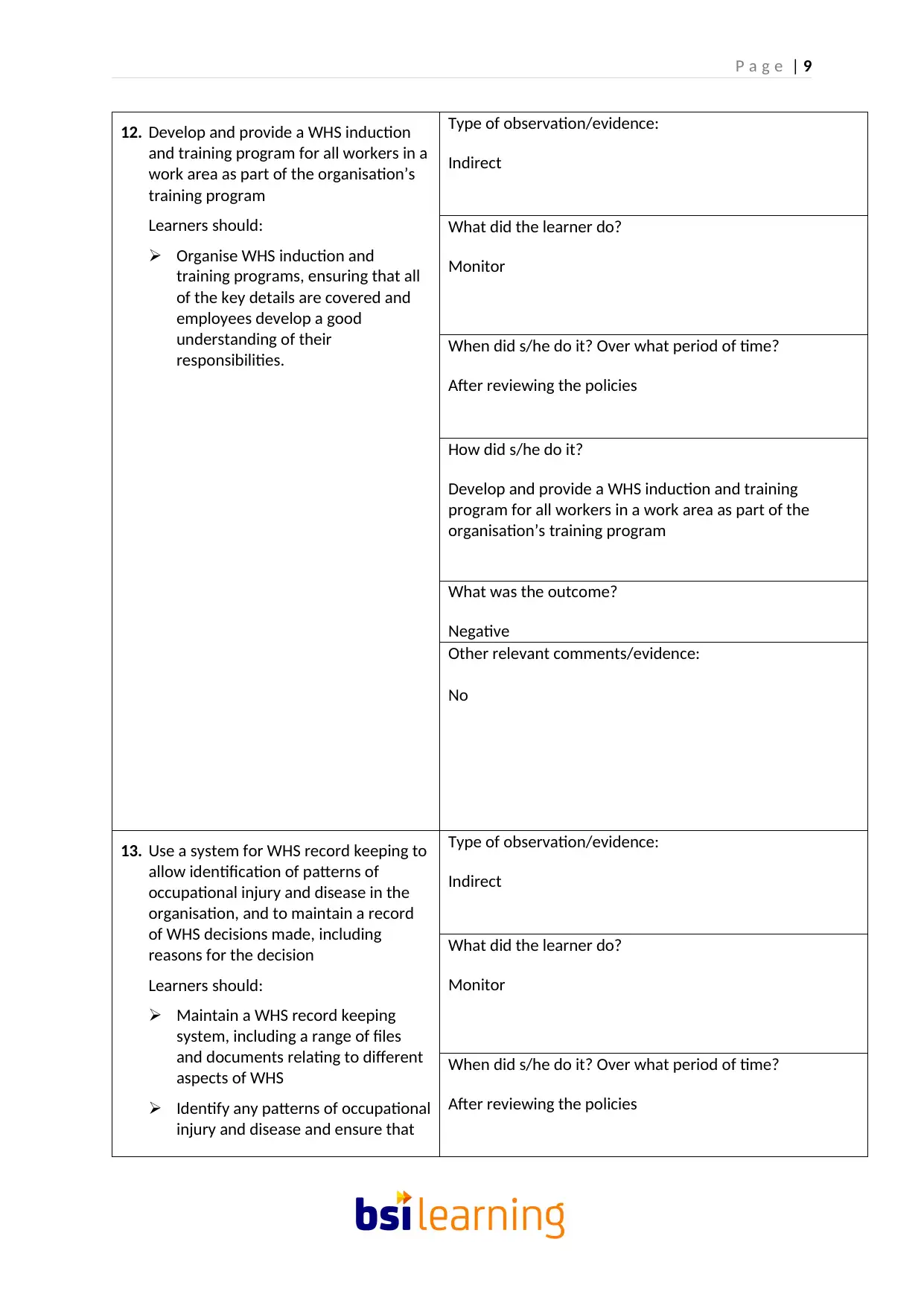
P a g e | 9
12. Develop and provide a WHS induction
and training program for all workers in a
work area as part of the organisation’s
training program
Learners should:
Organise WHS induction and
training programs, ensuring that all
of the key details are covered and
employees develop a good
understanding of their
responsibilities.
Type of observation/evidence:
Indirect
What did the learner do?
Monitor
When did s/he do it? Over what period of time?
After reviewing the policies
How did s/he do it?
Develop and provide a WHS induction and training
program for all workers in a work area as part of the
organisation’s training program
What was the outcome?
Negative
Other relevant comments/evidence:
No
13. Use a system for WHS record keeping to
allow identification of patterns of
occupational injury and disease in the
organisation, and to maintain a record
of WHS decisions made, including
reasons for the decision
Learners should:
Maintain a WHS record keeping
system, including a range of files
and documents relating to different
aspects of WHS
Identify any patterns of occupational
injury and disease and ensure that
Type of observation/evidence:
Indirect
What did the learner do?
Monitor
When did s/he do it? Over what period of time?
After reviewing the policies
12. Develop and provide a WHS induction
and training program for all workers in a
work area as part of the organisation’s
training program
Learners should:
Organise WHS induction and
training programs, ensuring that all
of the key details are covered and
employees develop a good
understanding of their
responsibilities.
Type of observation/evidence:
Indirect
What did the learner do?
Monitor
When did s/he do it? Over what period of time?
After reviewing the policies
How did s/he do it?
Develop and provide a WHS induction and training
program for all workers in a work area as part of the
organisation’s training program
What was the outcome?
Negative
Other relevant comments/evidence:
No
13. Use a system for WHS record keeping to
allow identification of patterns of
occupational injury and disease in the
organisation, and to maintain a record
of WHS decisions made, including
reasons for the decision
Learners should:
Maintain a WHS record keeping
system, including a range of files
and documents relating to different
aspects of WHS
Identify any patterns of occupational
injury and disease and ensure that
Type of observation/evidence:
Indirect
What did the learner do?
Monitor
When did s/he do it? Over what period of time?
After reviewing the policies
Paraphrase This Document
Need a fresh take? Get an instant paraphrase of this document with our AI Paraphraser
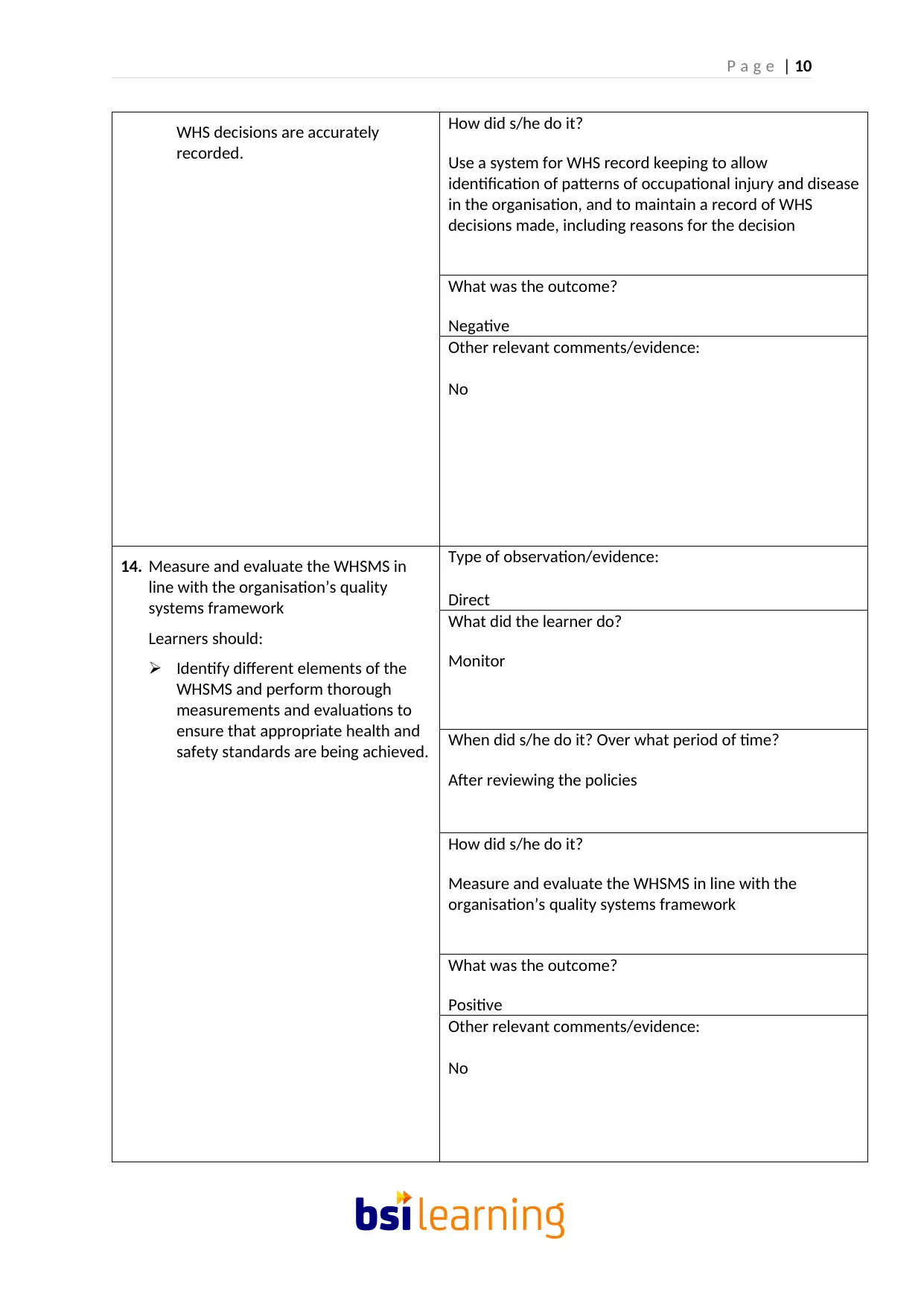
P a g e | 10
WHS decisions are accurately
recorded.
How did s/he do it?
Use a system for WHS record keeping to allow
identification of patterns of occupational injury and disease
in the organisation, and to maintain a record of WHS
decisions made, including reasons for the decision
What was the outcome?
Negative
Other relevant comments/evidence:
No
14. Measure and evaluate the WHSMS in
line with the organisation’s quality
systems framework
Learners should:
Identify different elements of the
WHSMS and perform thorough
measurements and evaluations to
ensure that appropriate health and
safety standards are being achieved.
Type of observation/evidence:
Direct
What did the learner do?
Monitor
When did s/he do it? Over what period of time?
After reviewing the policies
How did s/he do it?
Measure and evaluate the WHSMS in line with the
organisation’s quality systems framework
What was the outcome?
Positive
Other relevant comments/evidence:
No
WHS decisions are accurately
recorded.
How did s/he do it?
Use a system for WHS record keeping to allow
identification of patterns of occupational injury and disease
in the organisation, and to maintain a record of WHS
decisions made, including reasons for the decision
What was the outcome?
Negative
Other relevant comments/evidence:
No
14. Measure and evaluate the WHSMS in
line with the organisation’s quality
systems framework
Learners should:
Identify different elements of the
WHSMS and perform thorough
measurements and evaluations to
ensure that appropriate health and
safety standards are being achieved.
Type of observation/evidence:
Direct
What did the learner do?
Monitor
When did s/he do it? Over what period of time?
After reviewing the policies
How did s/he do it?
Measure and evaluate the WHSMS in line with the
organisation’s quality systems framework
What was the outcome?
Positive
Other relevant comments/evidence:
No
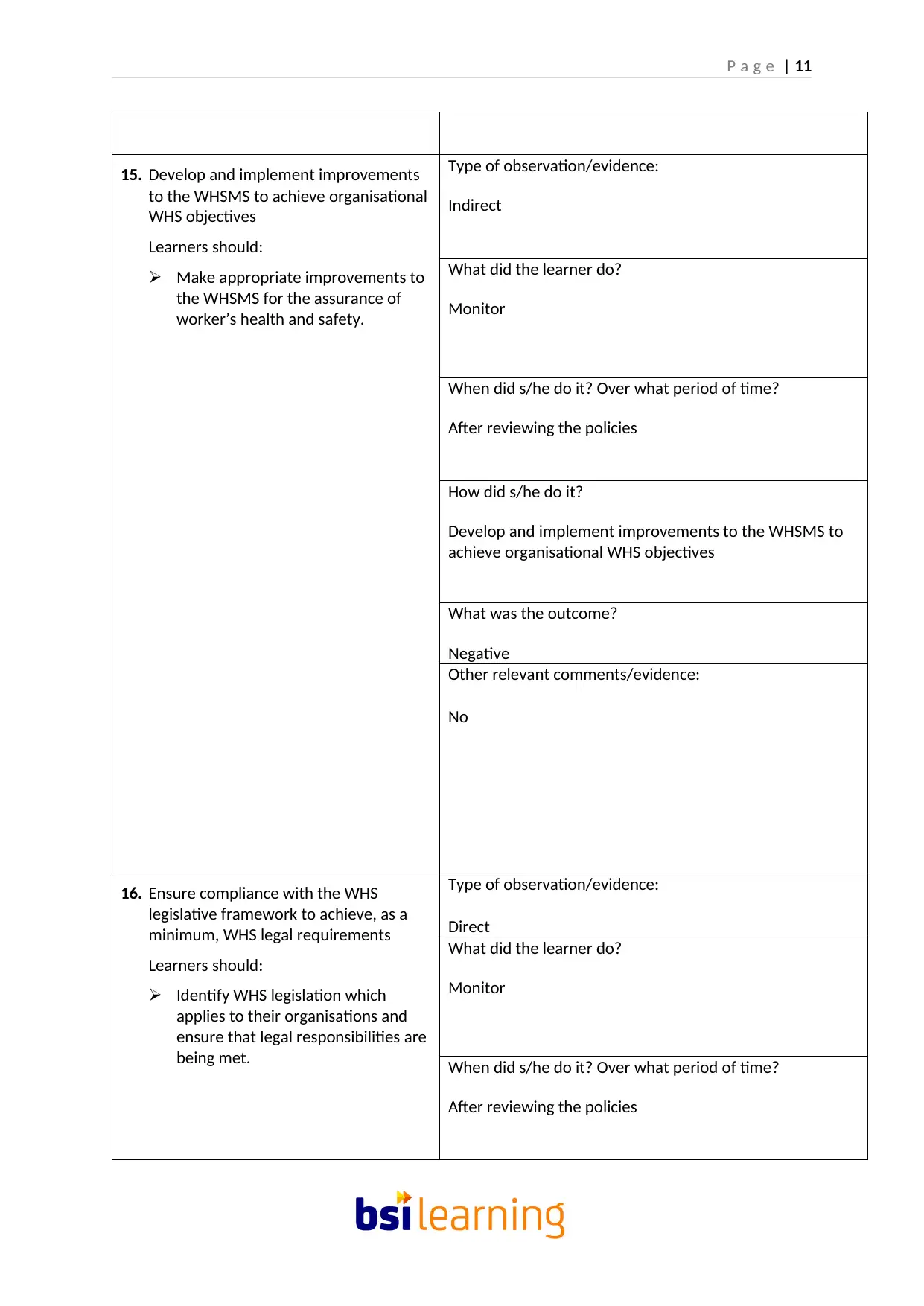
P a g e | 11
15. Develop and implement improvements
to the WHSMS to achieve organisational
WHS objectives
Learners should:
Make appropriate improvements to
the WHSMS for the assurance of
worker’s health and safety.
Type of observation/evidence:
Indirect
What did the learner do?
Monitor
When did s/he do it? Over what period of time?
After reviewing the policies
How did s/he do it?
Develop and implement improvements to the WHSMS to
achieve organisational WHS objectives
What was the outcome?
Negative
Other relevant comments/evidence:
No
16. Ensure compliance with the WHS
legislative framework to achieve, as a
minimum, WHS legal requirements
Learners should:
Identify WHS legislation which
applies to their organisations and
ensure that legal responsibilities are
being met.
Type of observation/evidence:
Direct
What did the learner do?
Monitor
When did s/he do it? Over what period of time?
After reviewing the policies
15. Develop and implement improvements
to the WHSMS to achieve organisational
WHS objectives
Learners should:
Make appropriate improvements to
the WHSMS for the assurance of
worker’s health and safety.
Type of observation/evidence:
Indirect
What did the learner do?
Monitor
When did s/he do it? Over what period of time?
After reviewing the policies
How did s/he do it?
Develop and implement improvements to the WHSMS to
achieve organisational WHS objectives
What was the outcome?
Negative
Other relevant comments/evidence:
No
16. Ensure compliance with the WHS
legislative framework to achieve, as a
minimum, WHS legal requirements
Learners should:
Identify WHS legislation which
applies to their organisations and
ensure that legal responsibilities are
being met.
Type of observation/evidence:
Direct
What did the learner do?
Monitor
When did s/he do it? Over what period of time?
After reviewing the policies
⊘ This is a preview!⊘
Do you want full access?
Subscribe today to unlock all pages.

Trusted by 1+ million students worldwide
1 out of 44
Related Documents
Your All-in-One AI-Powered Toolkit for Academic Success.
+13062052269
info@desklib.com
Available 24*7 on WhatsApp / Email
![[object Object]](/_next/static/media/star-bottom.7253800d.svg)
Unlock your academic potential
Copyright © 2020–2025 A2Z Services. All Rights Reserved. Developed and managed by ZUCOL.




